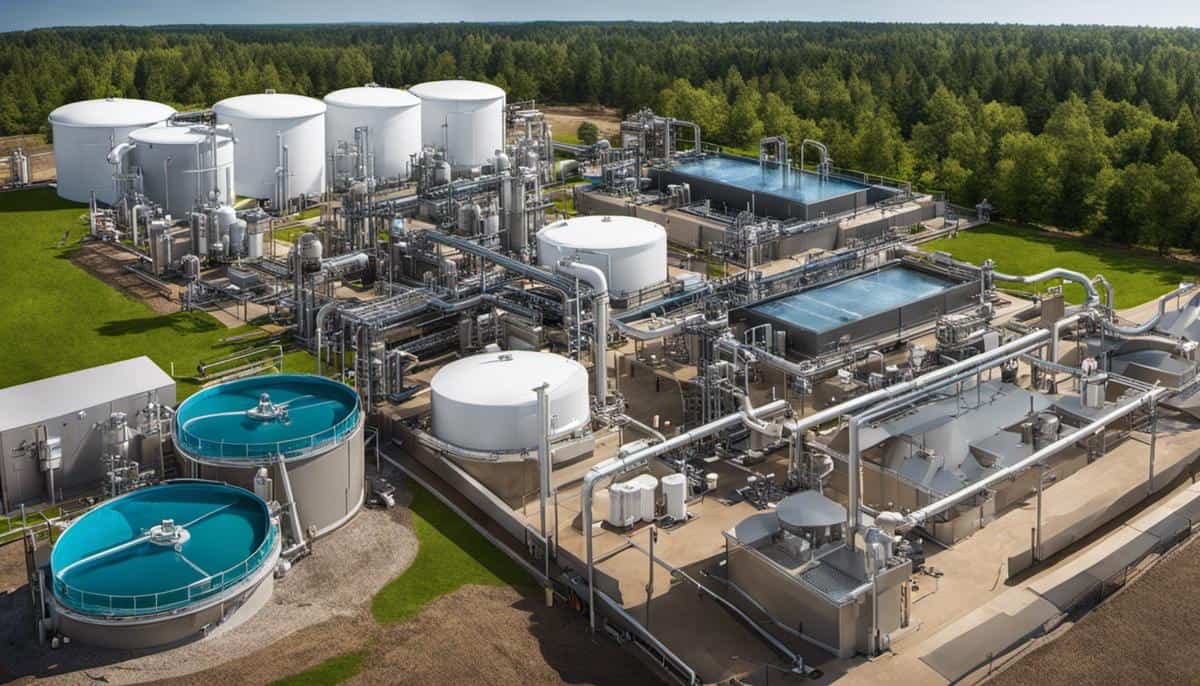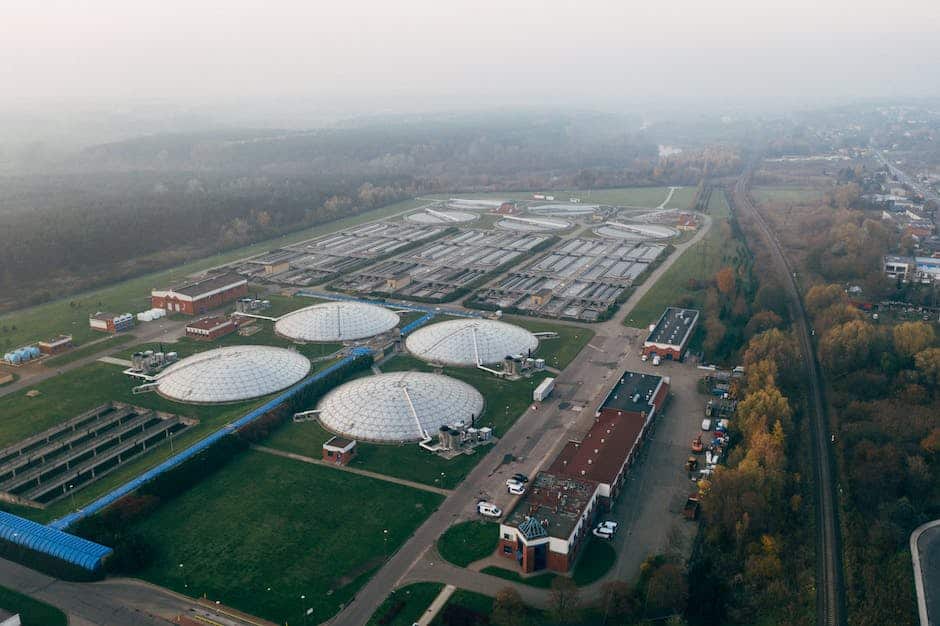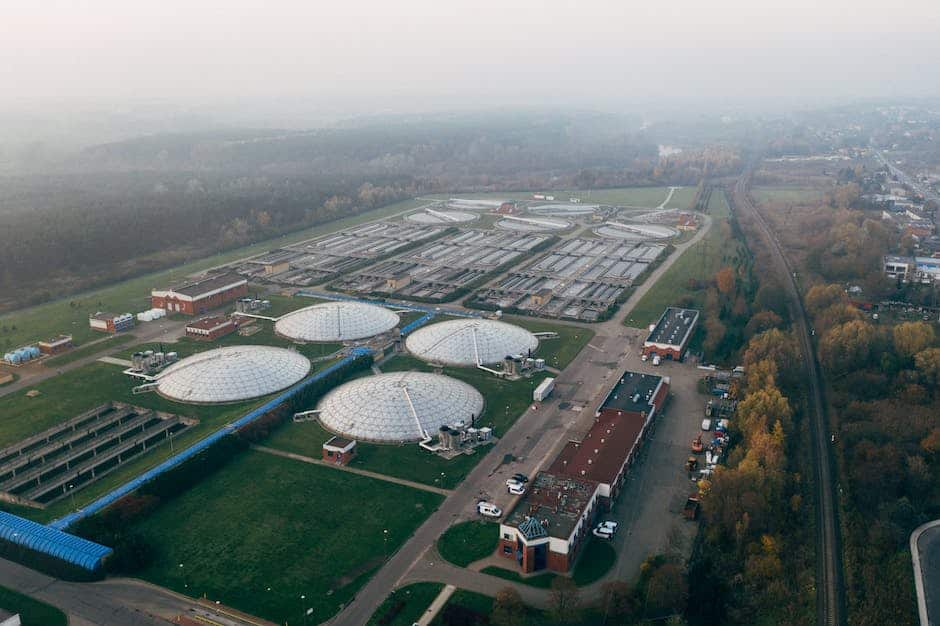
30 Oct Understanding Commercial Wastewater Treatment Systems
With skies teeming with the relentless march of industrial advancement, the reliable management of commercial wastewater treatment has never been more critical. As industries sprawl and societies consume, the waste we generate is an unavoidable footprint of our progress. The efficient treatment of commercial wastewater, therefore, is not just concerned with safeguarding our environment; it is intrinsically linked to the sustainability of our industries, economies, and indeed, our civilization. This discussion touches upon the fundamental processes that underpin commercial wastewater systems, explores the cutting-edge technologies reshaping this landscape, evaluates the regulatory and environmental contexts in which these systems operate, before finally gazing into the compelling vista of future trends and challenges.
Fundamentals of Commercial Wastewater Treatment
Unmasking the Principles and Components of Commercial Wastewater Treatment Systems
Water, as a central component of life and industry, is a resource that often passes under our radar. Yet, the critical processes involved in reclaiming wastewater for safe use cannot be understated. Such process, paired with the advent of advanced technologies, led to the birth of commercial wastewater treatment systems. To truly appreciate these systems and their value, we must delve into the underlying operating principles and key components involved in their operation.
Firstly, the underlying operating principle of any wastewater treatment system is the removal of contaminants. This is achieved through physical, chemical, and biological processes that ultimately render it safe for reintroduction into the environment. The level of treatment required for reused or recycled wastewater largely depends on its intended use — be it for irrigation, groundwater recharge, industrial processes, or drinking.
A crucial first step in the treatment process is preliminary treatment, which functions primarily to reduce, remove, or alter the characteristics of the effluent to further treat downstream. Here, the wastewater undergoes screening to remove large objects, grit removal to eliminate heavy particles and, in some instances, flow equalization. Allow us to underscore the inherent necessity of this first stage, because the removal of these potential system cloggers forms the foundation for effective further treatment.
Delving deeper, primary treatment involves sedimentation, a physical process that allows solids to settle due to gravity’s influence. The resulting sludge is subsequently treated, while the remaining supernatant undergoes secondary treatment. As one of the most important steps, secondary treatment employs biological processes to remove dissolved organic matter through microbial action. Aeration tanks accelerate these processes, where organisms consume the organic matter and convert it into biomass.
Notably, secondary clarification follows, revolving around the settling and collection of the biomass or sludge from the water. This clarification process leverages gravity, with heavy particles collecting at the bottom and being returned to the aeration tanks as Returned Activated Sludge (RAS). The process not only reduces internal organic pollutant loading but also stabilizes the microbial populations ensuring a system balance.
Final steps of commercial wastewater treatment include tertiary or advanced treatment, disinfection, and sludge treatment. Tertiary treatment — depending on the desired water quality — might involve nutrient removal or fine filtration. Disinfection, however, is paramount to ensure that pathogens are eradicated or rendered harmless, using chlorination or UV radiation most typically.
Finally, the product of the entire process, sludge, undergoes thickening, digestion, dewatering, and disposal. Solid waste management aligns with the sustainable ideals of recycling and reclaiming resources, therefore, treatment of this ‘end product’ grants context to the holistic water treatment process.
In conclusion, it is the intimate understanding of these principles and components that ensure the effectiveness of commercial wastewater treatment. Despite the technical nature and complexity involved in their design and execution, the end purpose remains resolute: to ensure the safe and sustainable use of our most precious resource – water. Such systems truly epitomize human ingenuity and our inherent responsibility towards environmental stewardship. Their existence underscores a significant stride towards a future where water security, sustainability, and responsible resource management are attainable realities.

Technological Innovations in Commercial Wastewater Treatment
Advancements in Commercial Wastewater Treatment Technologies: A New Chapter in Resource Management
As our civilization progresses towards a more sustainable future, embracing innovations in every sector is a necessity. The field of environmental engineering and specifically wastewater treatment has not been exempt from this technological evolution. While the foundational principles of wastewater treatment systems, from preliminary treatment to sludge management, remain constant, the application of new technology to these existing processes permits a refined and more efficient approach to resource management and sustainability.
Currently, an array of fascinating technological advancements are helping to push commercial wastewater treatment into a new epoch. Here are a few of those advancements:
-
Membrane Bioreactor (MBR): MBR technology combines secondary and tertiary treatment by integrating a membrane filtration process with a suspended growth bioreactor. This innovative technology allows for a smaller footprint and superior effluent quality due to the virtually complete removal of solids.
-
Advanced Oxidation Processes (AOP): The term refers to several treatment methods designed to remove organic, and often difficult-to-treat, materials from water and wastewater. AOPs use (directly or indirectly) the highly reactive hydroxyl radical (•OH) to breakdown organics in the wastewater stream. Enhanced by either ozone, hydrogen peroxide, or ultraviolet light, this process is efficient at breaking down complex organic compounds.
-
Nanofiltration and Reverse Osmosis: Nano-filtration is a pressure-driven process that removes solutes from water via a semi-permeable membrane. It is increasingly being used to remove hardness and organic compounds from water. On the other hand, reverse osmosis removes inorganic compounds and contaminants using a high-pressure pump. Both processes are being utilized in areas with water scarcity to reuse commercial wastewater.
-
Bio-Electrochemical Systems: Bio-electrochemical systems represent a cutting-edge combination of microbiology and electrochemistry. In a nutshell, these systems utilize microbes that can generate electricity while degrading organic pollutants and also retrieve valuable products from wastewater.
-
Artificial Intelligence (AI) and Machine Learning: The application of AI and machine learning to commercial wastewater management is a truly promising development. Intelligent algorithms can optimize treatment processes, predict system failures, and provide real-time updates on system performance, thereby reducing operational costs and improving system efficiency.
In summary, the amalgamation of these innovative technologies into our current wastewater treatment systems promises the brighter advent of sustainable water and resource management. While the journey is far from over, it is without a doubt that the integration of these advanced technologies will help in crafting a future where water scarcity is a problem of the past.
As the drumbeat of progress continues its relentless rhythm, we in the scientific community take pride in our contributions and look forward with anticipation to what still lies on the horizon in our pursuit of the perfect balance between human prosperity and environmental sustainability. The exploration and adoption of these technological advancements truly embody our shared commitment to the cause of water security and sustainable resource management.

Regulatory and Environmental Aspects
Regulatory Guidelines for Commercial Wastewater Treatment
Ensuring compliance with regulatory guidelines forms an integral part of wastewater management. These requisite standards are designed to ensure the protection of both human health and the environment, promulgating the need for precise and competent engineering control measures.
The U.S. Environmental Protection Agency (EPA), under the provisions of the Clean Water Act, implements the National Pollutant Discharge Elimination System (NPDES). The NPDES makes it mandatory for establishments discharging pollutants from a point source into waters of the United States to procure a permit – a regulatory guideline to maintain water integrity and sustainability.
In addition, the EPA also executes the Pretreatment Program which regulates industrial dischargers to ensure that harmful pollutants are not discharged into municipal wastewater treatment systems. The guidelines, though designed to maintain engineered system efficiency, also ensure that the subsequent effluents can sustain aquatic life and meet human health benchmarks.
Furthermore, the biosolids, a byproduct of wastewater treatment, are subject to regulation under the Code of Federal Regulations (40 CFR Part 503). The rule establishes standards for the final use or disposal of biosolids to protect public health and the environment.
Environmental Implications of Commercial Wastewater Treatment
Turning our focus towards the broader environment, commercial wastewater treatment possesses multifaceted implications: biochemical, ecological, as well as climate change-associated facets.
Exceeding nutrient loads, primarily nitrates and phosphates, resulting from inadequate treatment, can trigger eutrophication in surface waters; a condition leading to harmful algal blooms and subsequent dead zones. Similarly, the failure to remove harmful pathogens during treatment can lead to waterborne diseases, affecting both human and animal life.
Strikingly, the wastewater arena is not detached from climate change discourse. Traditional wastewater treatment systems heavily rely on energy, contributing to greenhouse gas emissions, a significant contributor to global warming. Anaerobic digestion, a prominent sludge stabilization method, though effective, potentially releases methane, a potent greenhouse gas.
However, innovation and advancement in wastewater treatment can ingeniously wield this challenge. For instance, biogas, a byproduct from anaerobic digestion, can be harnessed for energy recovery, forming a green and renewable energy source, revolutionizing the waste-to-energy narrative.
Finally, wastewater treatment technologies such as Membrane Bioreactor (MBR), Advanced Oxidation Processes (AOP), nanofiltration, reverse osmosis, bio-electrochemical systems, and AI-driven approaches are emerging at the cusp of this evolutionary trajectory. While providing enhanced efficiencies, these technologies also help maintain a balance with the environment and the evolving regulatory landscape.
Thus, mastering the application of commercial wastewater treatment technologies and complying with requisite regulatory guidelines are prudent strides towards a sustainable future. The height of this craft is not just in the decontamination but rises through the lens of environmental stewardship, resource recovery, and climate-responsive strategies.
Future Trends and Challenges in Commercial Wastewater Treatment
Looking ahead towards the future of commercial wastewater treatment systems, it is evident that recent advancements in technology and growing environmental concerns will play substantial roles in shaping the evolution of these systems.
The innovative technologies drafted to step in, such as Membrane Bioreactor (MBR), Advanced Oxidation Processes (AOP), Nanofiltration, Reverse Osmosis, Bio-Electrochemical Systems, along with Artificial Intelligence (AI) and Machine Learning, may soon revolutionize the way wastewater is treated.
Membrane Bioreactor (MBR) combines the process of membrane filtration with biological treatment, a promising prospect for the removal of different classes of pollutants. MBR offers a more streamlined solution for wastewater treatment, given its high efficiency, compact design, and superior effluent quality.
On the other hand, Advanced Oxidation Processes (AOP) represents another leap in wastewater treatment technology. Using a combination of ozone, hydrogen peroxide, and UV light, AOP can eradicate a wide array of contaminants, including persistent organic pollutants that conventional treatment methods often fail to remove.
Yet, the exploration doesn’t cease here. The promise shown by nanofiltration and reverse osmosis in water purification cannot be overlooked. They can effectively remove micro-pollutants, salts, hardness, and organic matter from wastewater.
Moreover, the innovative Bio-Electrochemical Systems (BES) open the floor to energy-efficient treatment methods. Utilizing microorganisms as catalysts, BES generate electricity directly from organic and inorganic matter presenting a sustainable alternative that could drastically reduce the energy footprint of wastewater treatment processes.
Recognizing the complex nature of wastewater treatment, AI and machine learning are being leveraged to optimize various treatment parameters. This digital leap can uncover patterns and relationships often missed by conventional methods, thereby aiding in better decision making and predictive analysis for more efficient outcomes.
However, navigating this landscape of technological advancements is not devoid of challenges. With enhanced technologies comes the necessity to update the U.S. Environmental Protection Agency (EPA) regulations and the National Pollutant Discharge Elimination System (NPDES). In addition, the Pretreatment Program for industrial dischargers and the regulation of biosolids under the Code of Federal Regulations need adjustments to address emerging wastewater treatment technologies adequately.
Another paramount challenge is the environmental implications of commercial wastewater treatment, such as eutrophication and waterborne diseases. The climate change-related risks, specifically the potential increase in greenhouse gas emissions from conventional wastewater treatment systems, demand an urgent call for action.
The paradigm shift in wastewater treatment, with technologies such as anaerobic digestion and biogas recovery, represents a vital step towards the reduction of carbon footprint. Opting for these renewable alternatives can not only contribute to environmental stability but also generate significant energy savings.
The conception and adoption of these emerging technologies are contingent on consistent research and financial backing. Not to forget, the importance of crossing the bridge between innovative research and practical implementation – a process that requires significant knowledge transfer, training, and adjustment of current standards.
The future of commercial wastewater treatment lies in the advent of innovative technologies, up-to-date regulations, and a heightened focus on sustainability and environmental responsibility. However, overcoming the challenges that accompany this future calls for a commitment to research, investment, knowledge sharing, and embracing change for the better. Truly, the possibilities can be as boundless and profound as the depths the science of wastewater management reaches into.

As we stand on the precipice of a new dawn in technology, innovation does not just offer promise; it compels us to redefine responsibility. While the revolution in commercial wastewater treatment attests to human ingenuity, our age-old mandate to respect and protect our environment endures. As population growth, industrialization, and climate change continue to impose new parameters, the sphere of wastewater treatment will inevitably adapt, transform, and innovate. The future challenges are considerable, and yet, seeped in these challenges are unique opportunities to refine our practices, reimagine our strategies, and recommit to our stewardship of the environment. Ensuring the sustainability of water resources, therefore, is not a lone battle; it is an ongoing dialogue between science, technology, regulation, and the environment – a dialogue that is integral to our existence, progress, and legacy.




Sorry, the comment form is closed at this time.